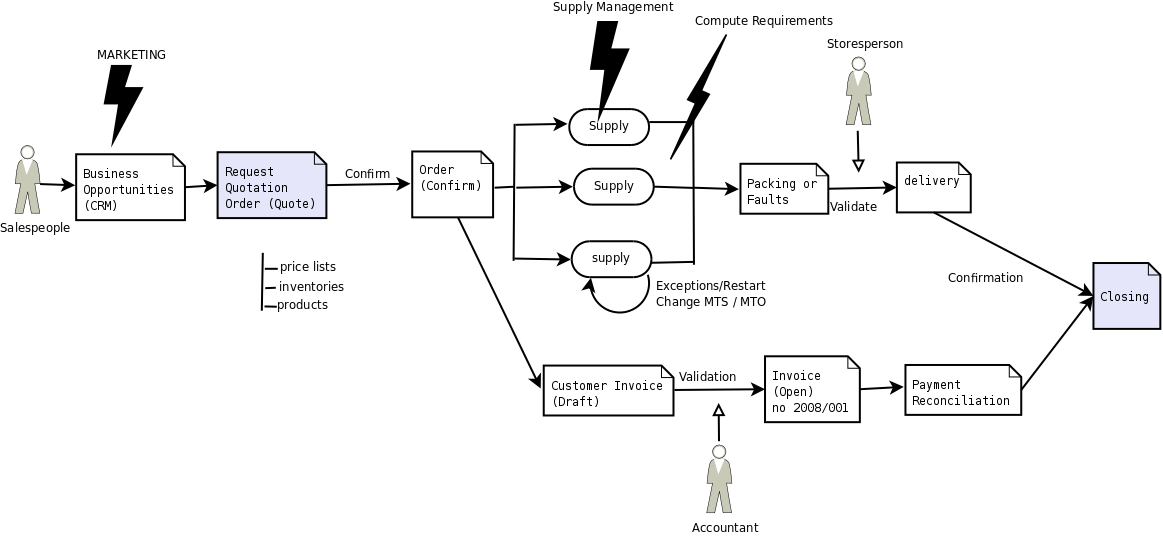Managing Service Contracts
Contracts can take different forms within Odoo ERPOnline, depending on their nature. So you can have several distinct types of service contracts, such as:
- fixed-price contracts,
- cost-reimbursement contracts, invoiced when services are completed,
- fixed-price contracts, invoiced monthly as services are carried out.
Some companies commit to contracts on the basis of a requested volume at a certain price for a defined period. In such a case, the contract is represented by a pricelist for that specific customer.
The pricelist is linked in the Sales and Purchases tab of the Customers form, so that it is brought up whenever anything is bought from or sold to this partner (depending on whether it is a purchase or sales agreement). Odoo ERPOnline automatically selects the price based on this agreed pricelist.
Fixed Price Contracts
Fixed price contracts for the sale of services are represented in Odoo ERPOnline by a Sales Order. In this case, the supply of services is managed just like all other stockable or consumable products.
You can add new orders using the menu Sales > Sales > Quotations.
The new Sales Order document starts in the Draft Quotation state, so the estimate has no accounting impact on the system until it is confirmed. When you confirm the order, your estimate moves into the state Sale Order.

Process for handling a Sales Order
Once the order has been approved, Odoo ERPOnline will automatically generate an invoice and/or a delivery document proposal based on the parameters you set in the order.
The invoice will be managed by the system depending on the setting of the field Shipping Policy on the order's second tab Other Information:
Payment Before Delivery: Odoo ERPOnline creates an invoice in the Draft state. Once this is confirmed and paid, the delivery is activated.Invoice on Order After Delivery: the delivery order is produced when the order is validated. A draft invoice is then created when the delivery has been completed.Shipping & Manual Invoice: Odoo ERPOnline starts the delivery from the confirmation of the order, and adds a button which you manually click when you are ready to create an invoice.Invoice From The Delivery: invoices are created from the picking stage.
The term 'delivery' should be taken in the broadest sense in Odoo ERPOnline. The effect of a delivery depends on the configuration of the sold product.
If its type is either Stockable Product or Consumable, Odoo ERPOnline will make a request for it to be sent for picking. If the product's type is Service, Odoo ERPOnline's scheduler will create a task in the project management system, or create a subcontract purchase order if the product's Routes is Make to Order.
Invoicing after delivery does as it says: invoicing for the services when the tasks have been closed.
When you sign a new contract, you can just enter the order into the system and Odoo ERPOnline will track the order.
This works well for small orders. But for large valued service orders, you might want to invoice several times through the contract, for example:
- 30% on order,
- 40% on completion,
- 30% one month after the system has gone into production.
In this case you should create several invoices for the one Sales Order. You have to do for this:
- Do not handle invoicing automatically from the Sales Order but carry out manual invoicing instead.
Cost-reimbursement Contracts
Some contracts are not invoiced from a price fixed on the order but from the cost of the services carried out. That is usually what happens in the building sector or in large projects.
The approach you use for this is totally different because instead of using the sales order as the basis of the invoice you use the analytic accounts. For this you have to install the module hr_timesheet_invoice.
An analytic account is created for each new contract. The following fields must be completed in this analytic account:
Partner: partner associated with the contract,Sale PricelistInvoicing
The selection of an invoicing rate is an indirect way of specifying that the project will be invoiced on the basis of analytic costs. This can take different forms, such as delivery of services, purchase of raw materials, and expense reimbursements.
Pricelists and Billing Rates
You can select a pricelist on the analytic account without having to use it to specify billing rates.
An example of this is a client project that is to be invoiced only indirectly from the analytic costs. Putting the pricelist on the analytic account makes it possible to compare the actual sales with a best case situation where all the services would be invoiced. To get this comparison you have to print the analytic balance from the analytic account.
Project Management and Analytic Accounts
Analytic Accounts is only available once you have installed the module account_analytic_analysis. It provides various global financial and operational views of a project manager's projects.
Fixed-price Contracts Invoiced as Services are Worked
For large-valued projects, fixed-price invoicing based on the sales order is not always appropriate. In the case of a services project planned to run for about six months, invoicing could be based on the following:
- 30% on order,
- 30% at the project mid-point,
- 40% at delivery.
Such an approach is often used in a company but there are other options. This method of invoicing can pose many problems for the organization and invoicing of the project:
- It is extremely difficult to determine if the project is on track or not. The endpoint is fuzzy, which can result in a tricky discussion with the client at the moment of final invoicing.
- If the project takes more or less time than forecast, it will effectively result in under- or over-invoicing during the project.
- Whether you get a proper return can depend on the client. For example, if the client takes a long time to sign off on project acceptance, you cannot invoice the remaining 40% even though you might have supplied the agreed service properly.
- The account manager and the project manager are often different people. The project manager has to alert the account manager about the moment that the client can be invoiced, but that moment can easily be forgotten or mistaken.
- The project can be fixed for service costs but have agreed extras, such as reimbursement for travel expenses. Invoicing from the order does not adapt well to such an approach.
Odoo ERPOnline provides a third method for invoicing services that can be useful on long projects. This consists of invoicing the project periodically on the basis of time worked up to a fixed amount that cannot be exceeded. At the end of the project, a final invoice or a credit note is generated to meet the total amount of value fixed for the project.
To configure such a project you must set an invoicing rate, a pricelist and a maximum amount on the analytic account for the project. The services are then invoiced throughout the project by the different project or account managers, just like projects that are invoiced by time used. The managers can apply a refund on the final invoice if the project takes more time to complete than permitted under the contract.
When the project is finished you can generate the closing invoice. This automatically calculates the final balance of the bill, taking the amounts already charged into account. If the amount already invoiced is greater than the maximum agreed amount, then Odoo ERPOnline generates a draft credit note.
This approach offers many advantages compared with the traditional methods of invoicing in phases for fixed-price contracts:
- Fixed-price contracts and cost-reimbursable contracts are invoiced in the same way, which makes the company's invoicing process quite simple and systematic even when the projects are mixed.
- Everything is invoiced on the basis of worked time, making it easy to forecast invoicing from plans linked to the different analytical accounts.
- This method of proceeding educates project managers just as much as the client because refunds have to be given for work done if the project slips.
- Invoicing follows the course of the project and avoids a supplier's dependence on the goodwill of the client in approving certain phases.
- Invoicing of expenses follows the same workflow and is therefore very simple.
In contract negotiation, invoicing conditions are often neglected by the client. So it can often be straightforward to apply this method of invoicing.
Contracts Limited to a Quantity
Finally, certain contracts are expressed in terms of a quantity rather than a fixed amount. Support contracts comprising a number of prepaid hours are a case in point. To generate such contracts in Odoo ERPOnline you should start by installing the module account_analytic_analysis.
Then you can set a maximum number of hours for each analytic account. When employees enter their time worked on the support contract in the timesheets, the hours are automatically deducted from the maximum set on each analytic account.
You must also name someone in the company responsible for renewing expired contracts. They become responsible for searching through the list of accounts showing negative remaining hours.
The client contract can be limited to a certain quantity of hours, and it can also be limited in time. For that, you set an end date for the corresponding analytic account.
